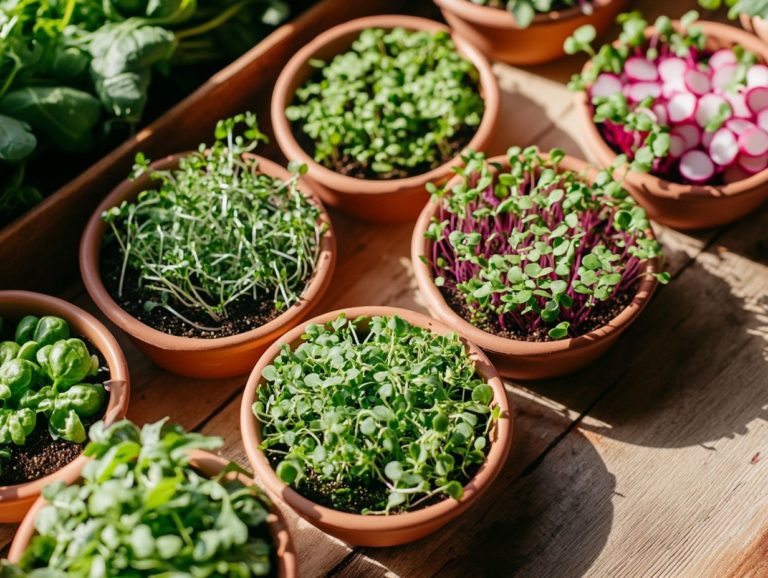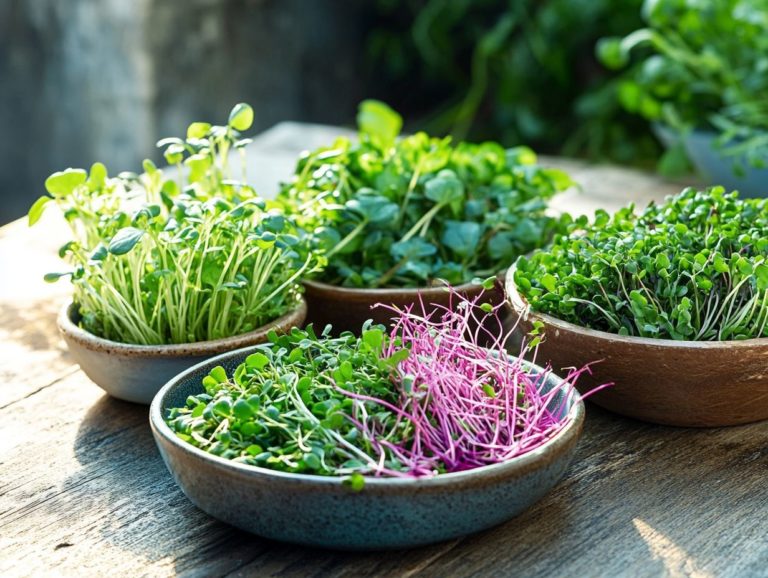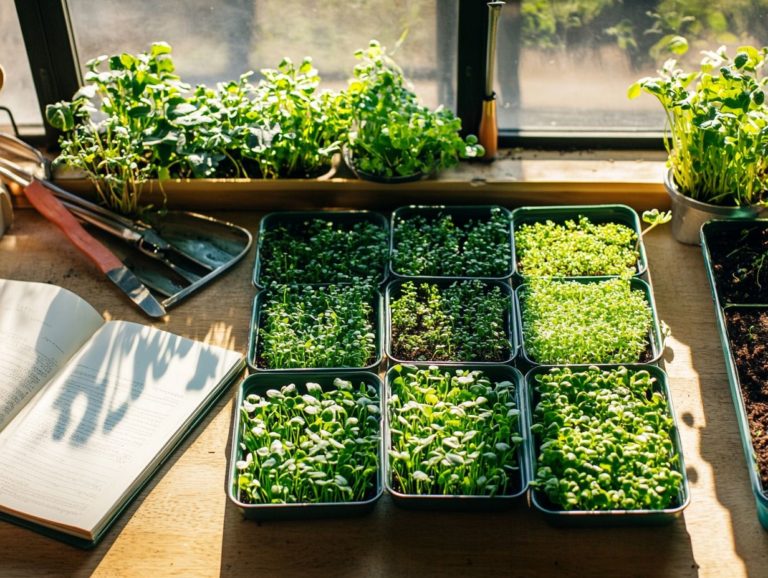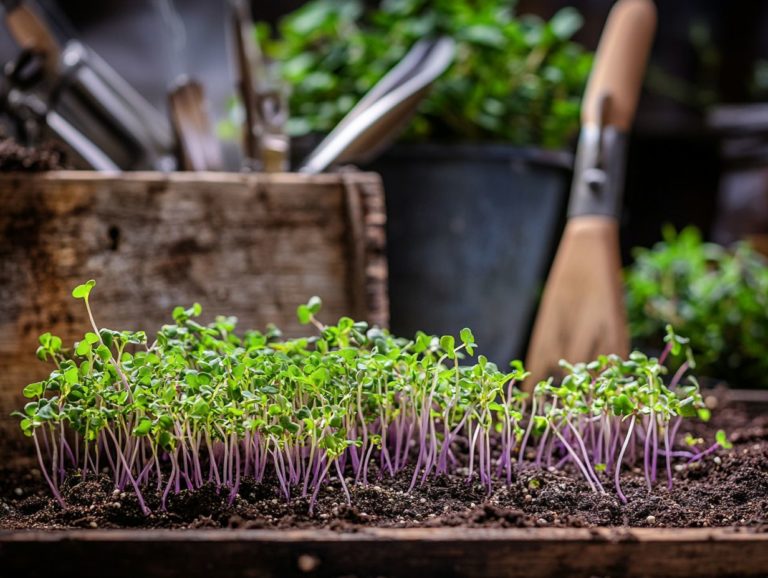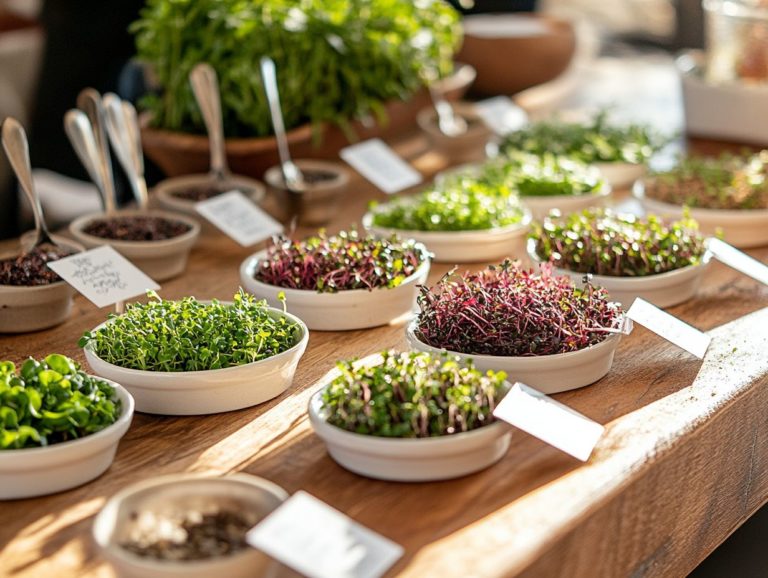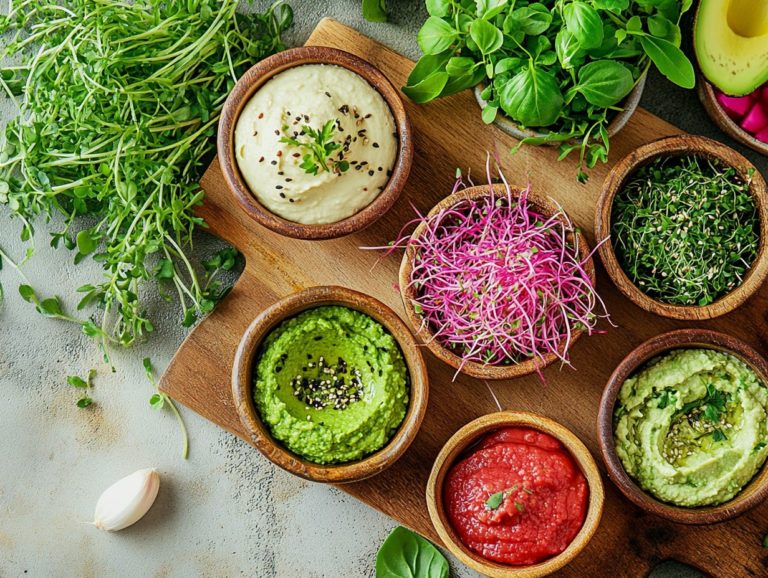Are Microgreens Safe to Eat Raw?
Microgreens and sprouts have surged in popularity, celebrated for their vibrant flavors and impressive nutritional profiles. But you might be wondering: Are they safe to eat raw?
This article delves into what microgreens, such as wheatgrass and cilantro, are and their nutritional value. It highlights the health benefits packed with nutrients and antioxidants while comparing the effects of consuming them raw versus cooked.
You’ll find an exploration of potential risks, including contamination concerns, along with practical tips for safe consumption. Dive in as you uncover the truth about microgreens and their role in a healthy diet, especially as part of a nutrient-dense meal plan.
Contents
- Key Takeaways:
- What are Microgreens?
- Health Benefits of Microgreens
- Raw vs. Cooked Microgreens
- Potential Risks of Eating Raw Microgreens
- How to Safely Consume Raw Microgreens
- Frequently Asked Questions
- Are microgreens safe to eat raw?
- Can I eat all types of microgreens raw, such as wheatgrass and cilantro?
- Are there any potential risks of eating raw microgreens, such as Salmonella?
- How should I store raw microgreens to maintain their nutrient-dense qualities?
- Can I cook microgreens like Swiss chard or nasturtium instead of eating them raw?
- Are there any health benefits to eating raw microgreens, like those from Brooks and Daughters?
Key Takeaways:
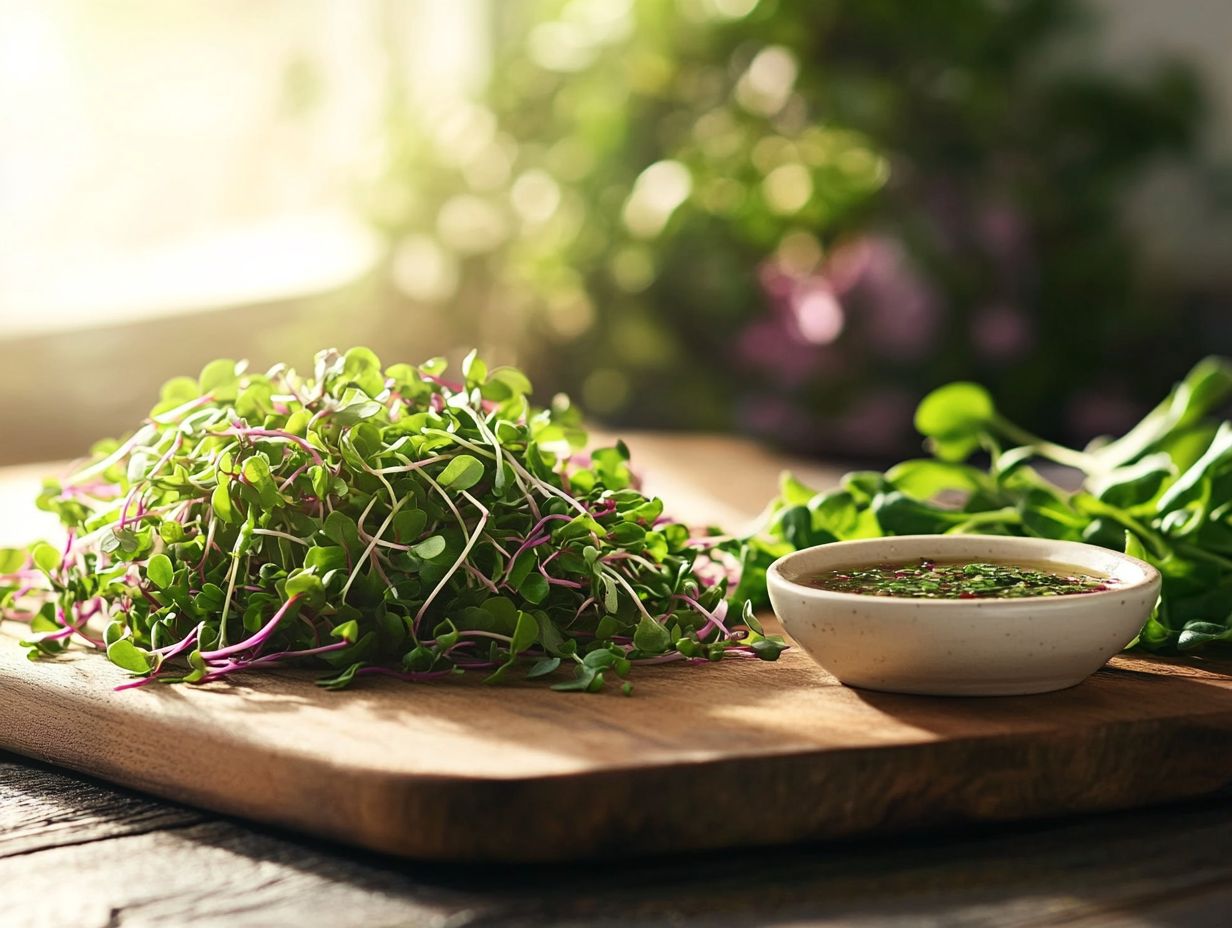
- Raw microgreens are safe to eat, but proper handling and preparation are key to avoiding potential risks of contamination and food safety concerns.
- In terms of nutritional value, raw microgreens may offer more benefits due to their high nutrient and antioxidant content compared to cooked microgreens, which are often considered young plants.
- It is important to follow safe handling practices to reap their health benefits.
What are Microgreens?
Microgreens are young edible plants harvested right after the first true leaves emerge. They deliver a delightful explosion of flavor, color, and nutrition that can elevate your culinary creations.
Cultivated in various environments, from hydroponic systems (growing plants in water without soil) to traditional soil, these nutrient-dense greens have gained immense popularity among both chefs and home cooks.
Their striking appearance and bold flavor have made them a must-have at local markets, such as the Ferry Plaza Farmers Market in San Francisco. Vendors like Corie Brooks of Brooks and Daughters proudly display their diverse array of offerings.
Definition and Nutritional Value
Microgreens are young edible plants that you harvest at an early stage of growth typically between 7 to 21 days after germination. They re celebrated for their impressive nutritional value.
These tiny greens are packed with vitamins, minerals, and antioxidants, often outshining their mature counterparts in nutrient concentration. For example, while mature spinach is known for its iron content, certain varieties of microgreens, like broccoli and kale, boast significantly higher levels of vitamins C, E, and K, along with essential minerals such as calcium and magnesium.
This impressive nutrient profile makes microgreens your secret weapon for better health! They enhance immunity and promote optimal digestion. By incorporating these vibrant greens into your meals, not only do you elevate the flavor, but you also gain a remarkable health boost something that nutritionists, chefs, and home cooks are increasingly recognizing.
Health Benefits of Microgreens
Microgreens and vegetables are more than just a delightful garnish for your dishes; they bring an impressive array of health benefits to the table. These tiny powerhouses are bursting with vitamins, minerals, and antioxidants that can significantly elevate your overall wellness.
Embracing microgreens, such as radish and watercress, in your meals is a simple yet effective way to nurture your body and enhance your culinary experience.
Rich in Nutrients and Antioxidants
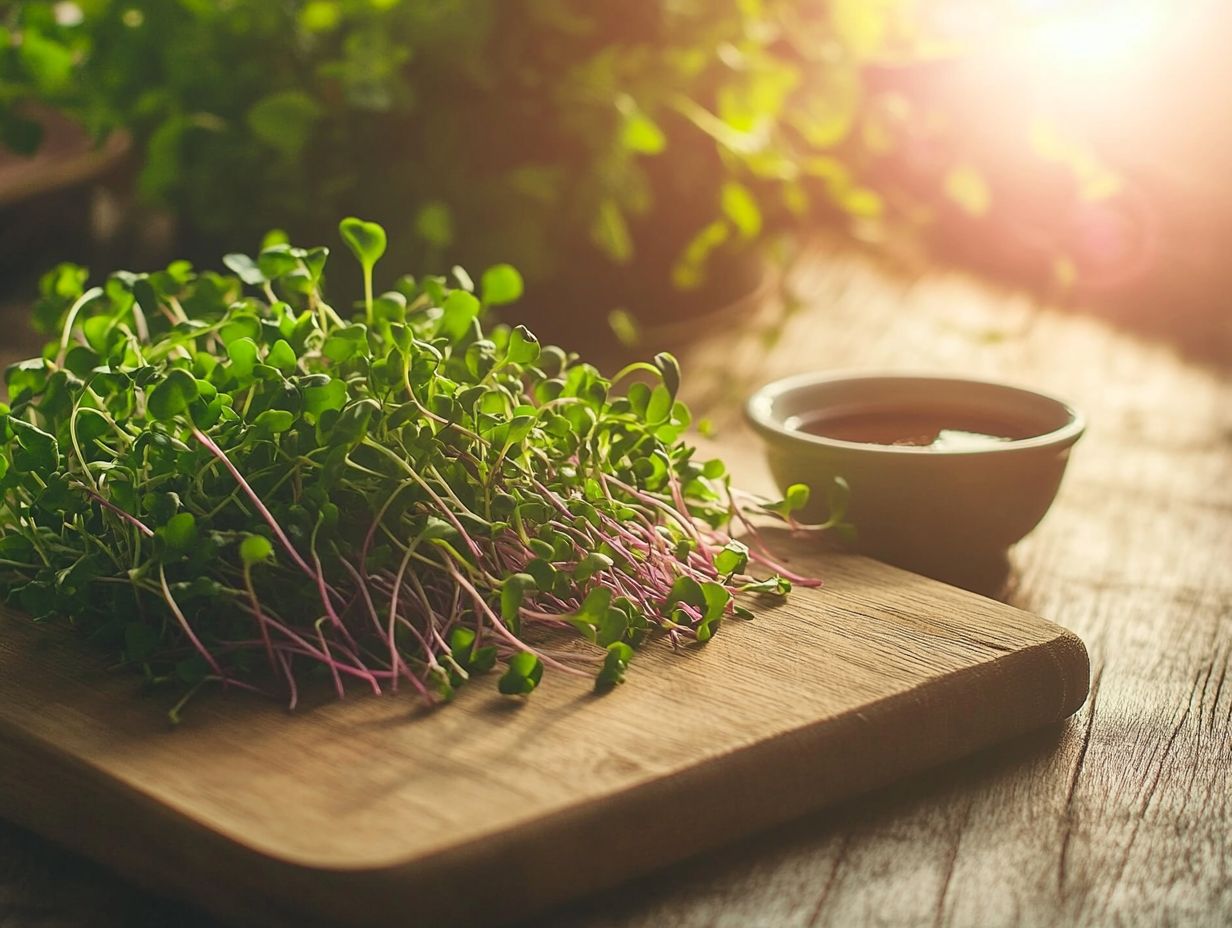
Microgreens are a nutritional powerhouse, brimming with essential nutrients and antioxidants that make them an invaluable addition to any health-focused diet. These tiny yet mighty plants think broccoli, kale, and radish microgreens, along with nasturtium and Swiss chard are teeming with vital vitamins like C, E, and K.
Take vitamin C, for instance. It s your immune system s best friend, helping to bolster your defenses. Then there s vitamin E, a remarkable antioxidant that shields your cells from damage. And let s not overlook vitamin K, which is essential for maintaining strong bones and supporting cardiovascular health.
By weaving these nutrient-dense microgreens into your meals, you can effortlessly elevate your antioxidant intake, promoting overall wellness and possibly lowering the risk of chronic illnesses.
Ready to add some vibrant flavors and health benefits to your meals? Let s dive into the world of microgreens together!
Raw vs. Cooked Microgreens
The discussion surrounding raw versus cooked microgreens hinges on the retention of nutrient content and essential food safety considerations. These factors can profoundly influence both the health benefits you derive and the cooking options you explore.
Comparing Nutrient Content and Safety
When comparing raw and cooked microgreens, including those grown in hydroponic systems, it s crucial to weigh both their nutrient content and safety. Preparation methods and food safety regulations can significantly influence the health benefits you receive.
Cooking microgreens often leads to a notable loss of essential nutrients, such as vitamins C and A, as well as vital phytonutrients, which are natural compounds in plants that provide health benefits. The cooking process breaks down water-soluble vitamins, reducing their beneficial effects.
However, consuming raw microgreens isn t without its risks, including potential foodborne illnesses like Salmonella or other pathogens, especially if proper handling practices are overlooked. To mitigate these risks, wash your microgreens thoroughly, such as those from Brooks and Daughters, and store them at safe temperatures.
Being aware of these food safety practices is key to reaping the rewards of microgreens without compromising your health.
Potential Risks of Eating Raw Microgreens
While raw microgreens present an array of health benefits, it’s important to acknowledge the potential risks associated with food safety. If not handled with care, these delicate greens can be vulnerable to contamination and foodborne illnesses, such as Salmonella.
Handle and store microgreens properly to fully enjoy their advantages without compromising your well-being.
Contamination and Food Safety Concerns
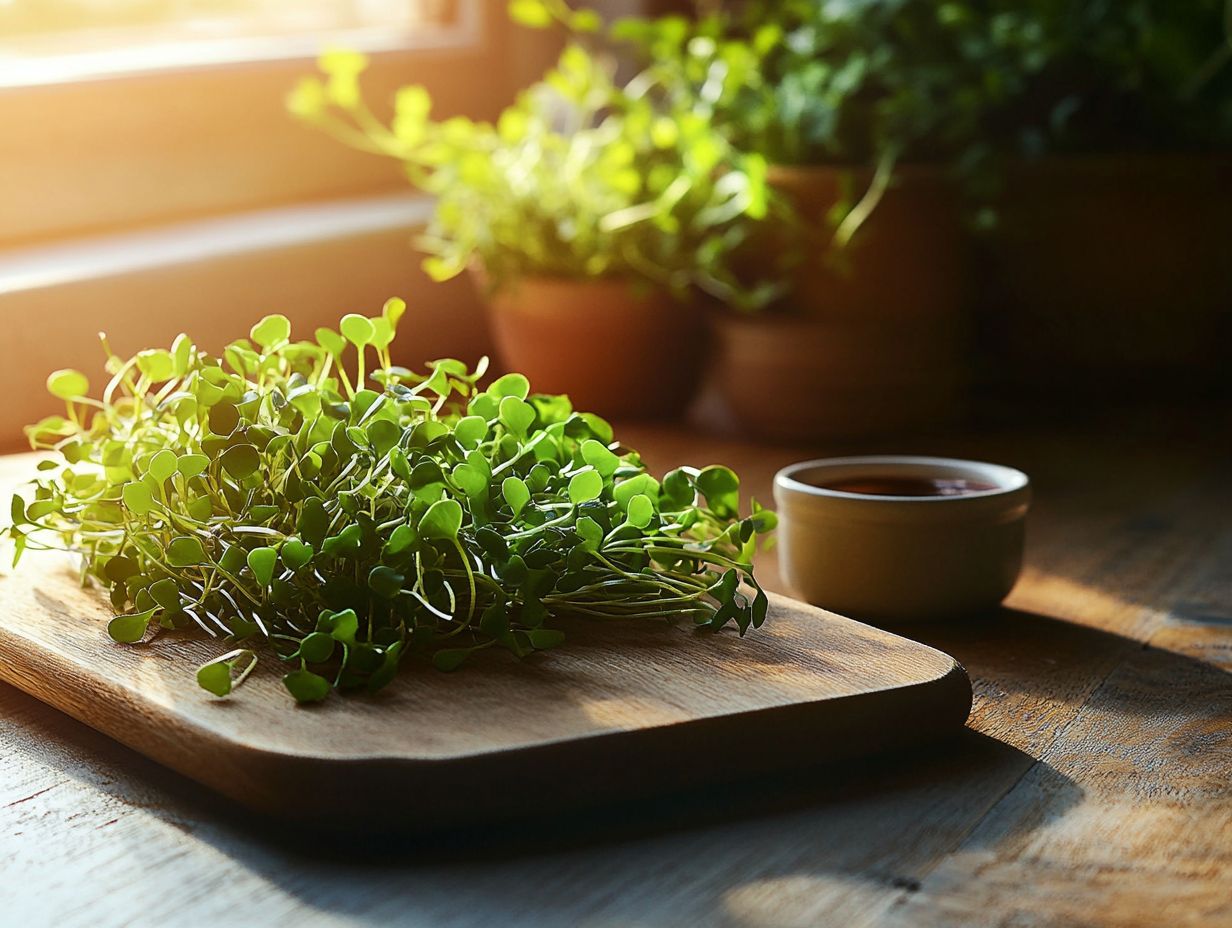
Contamination is a significant concern with raw microgreens, including those sold at the Ferry Plaza Farmers Market. Improper handling and inadequate food safety measures can lead to foodborne illness outbreaks, such as Salmonella.
Several factors contribute to these risks, from specific growing conditions used to cultivate microgreens to handling practices during harvesting and packaging. Microgreens flourish in warm, moist environments, which, if not meticulously monitored, can become breeding grounds for harmful pathogens. It’s crucial to learn how to identify edible microgreens to ensure safe consumption.
The use of contaminated water, poor sanitation practices, and insufficient employee training can heighten the risk of contamination. Therefore, adhering to stringent food safety regulations is crucial for both producers and retailers to ensure the safety of these nutritious greens.
By embracing best practices, sourcing from reputable suppliers, and conducting regular contamination tests, you can enjoy microgreens safely while minimizing health risks associated with foodborne pathogens. If you’re curious about their benefits, you might wonder, can microgreens improve my diet?
How to Safely Consume Raw Microgreens
To fully savor the diverse flavors and health benefits of raw microgreens and their short shelf life, it s crucial to adhere to best practices in food safety, along with proper handling and preparation techniques. This ensures that you can indulge in their freshness while maintaining the highest standards of quality and safety.
Tips for Proper Handling and Preparation
Proper handling and preparation of raw microgreens are essential for maintaining their quality and safety. This ensures they remain a nutritious addition to your meals.
Microgreens, often brimming with vitamins and minerals like those found in arugula and beet greens, deserve your careful attention to prevent any foodborne illnesses. Before savoring their vibrant flavors, it’s vital to wash them thoroughly under cool, running water. This step not only removes dirt but also eliminates potential contaminants. Additionally, you can explore how to use microgreens in cooking to enhance your dishes.
After washing, gently pat them dry with a clean cloth or paper towel to banish excess moisture, which can lead to spoilage. For optimal storage, store microgreens in a breathable container in the refrigerator, ideally away from other produce to minimize cross-contamination risks.
Always inspect them for signs of spoilage before use, as these delicate greens can deteriorate quickly.
Start incorporating microgreens into your meals today for a delicious health boost!
Weighing the Pros and Cons
When you contemplate adding raw microgreens to your diet, it s essential to balance the impressive health benefits with the potential risks tied to food safety and contamination.
These tiny, nutrient-rich greens include arugula, beet greens, cilantro, and nasturtium. They are packed with vitamins, minerals, and antioxidants. Microgreens offer a concentrated source of nourishment that can elevate the flavor and texture of various dishes.
It s crucial to understand the risks of consuming raw microgreens. Harmful pathogens like E. coli and Salmonella can be present, especially if sourced from unregulated environments.
If your immune system isn’t strong or you re concerned about foodborne illnesses, enjoy the vibrant taste of microgreens, but take a moment to ensure they re safe! Ensure that any raw microgreens you enjoy are thoroughly washed and ideally purchased from reputable sources.
This way, you can minimize potential health concerns while fully reaping the health benefits of these nutritious greens.
Frequently Asked Questions
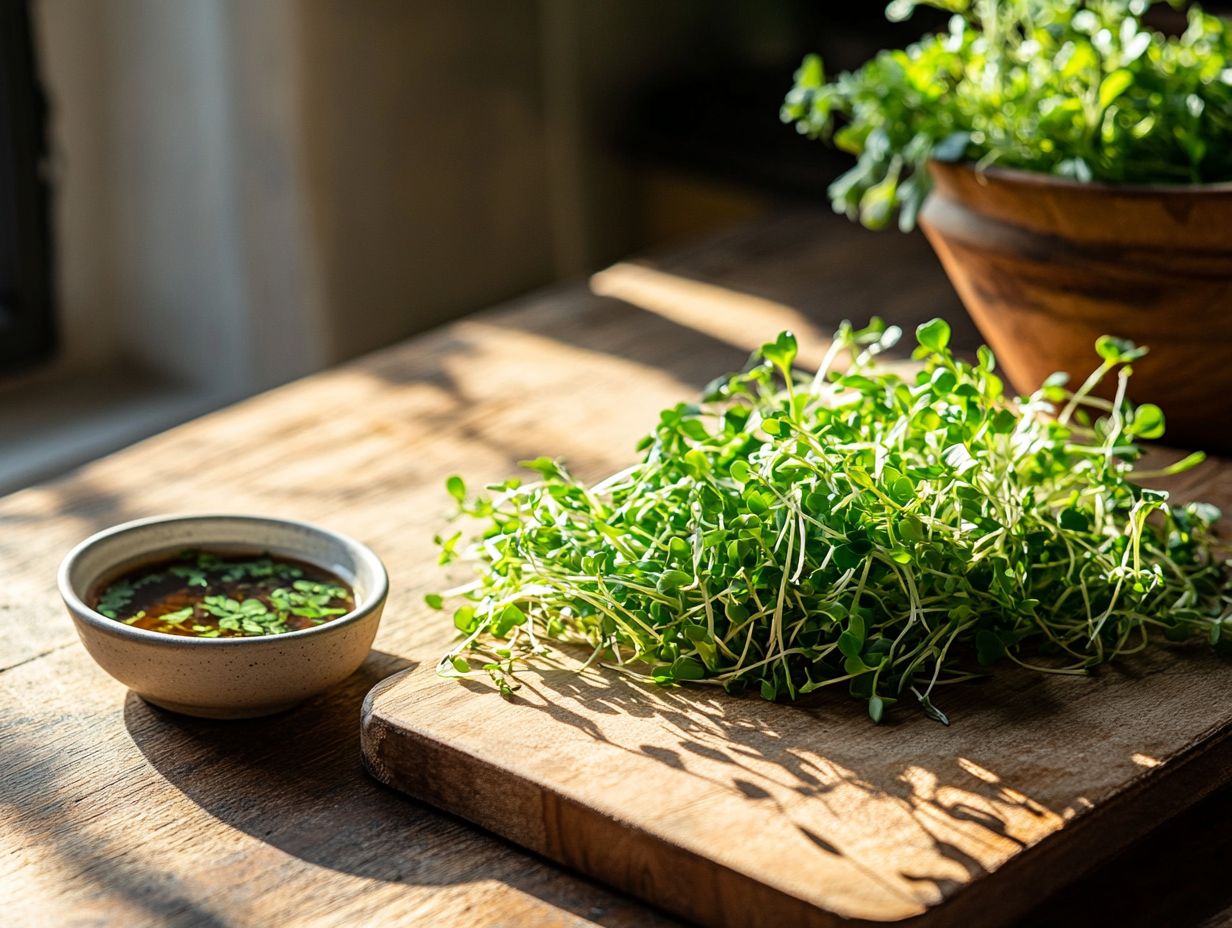
Are microgreens safe to eat raw?
Yes, microgreens are safe to eat raw as long as they are grown in a clean and hygienic environment.
Can I eat all types of microgreens raw, such as wheatgrass and cilantro?
Most types of microgreens can be eaten raw, but some may have a stronger flavor that may not be enjoyable for everyone. It’s best to try a small amount first to see if you like the taste.
Are there any potential risks of eating raw microgreens, such as Salmonella?
While rare, there is a slight risk of foodborne illness from consuming raw microgreens. This risk can be minimized by washing them thoroughly before consumption.
How should I store raw microgreens to maintain their nutrient-dense qualities?
Microgreens should be stored in the refrigerator in a sealed container or bag. They can last for about a week when stored properly.
Can I cook microgreens like Swiss chard or nasturtium instead of eating them raw?
Yes, microgreens can be cooked like any other vegetable. However, cooking may diminish some of their nutritional value.
Are there any health benefits to eating raw microgreens, like those from Brooks and Daughters?
Yes, raw microgreens are packed with nutrients and antioxidants that can provide numerous health benefits, such as improving digestion, boosting the immune system, and reducing inflammation.
Try adding fresh microgreens to your meals today for a burst of flavor and nutrition!

